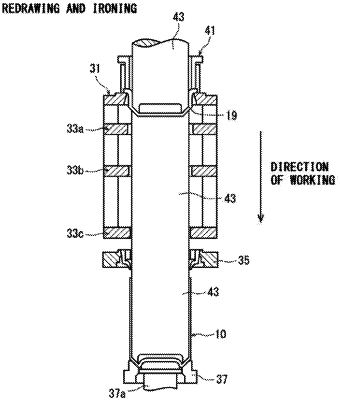| CPC B21D 22/28 (2013.01) [B21D 51/26 (2013.01); B21D 22/30 (2013.01); B65D 1/40 (2013.01)] | 2 Claims |

|
1. A draw-ironed blank can having a can body made of an aluminum alloy, wherein on an outer surface of the can body, a ratio Ra1/Ra2 of an arithmetic mean roughness Ra1 measured in a circumferential direction and an arithmetic mean roughness Ra2 measured in a direction of height is from 0.5 to 1.5, the arithmetic mean roughness Ra1 being not more than 0.030 μm, and a brightness ratio which is measured by an LCH (Lightness, Chroma, and Hue) method and represented by the following formula is from 0.7 to 1.3,
brightness ratio =L15w/L15h
wherein,
L15w is a brightness value of a light reflected by the outer surface of the can body having an angle of 15 degrees based on a specular light in the circumferential direction of the outer surface of the can body,
L15h is a brightness value of the light reflected by the outer surface of the can body having an angle of 15 degrees based on a specular light in the direction of height of the outer surface of the can body, and
said brightness value L15h is not less than 50.
|